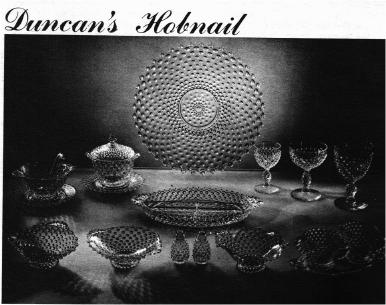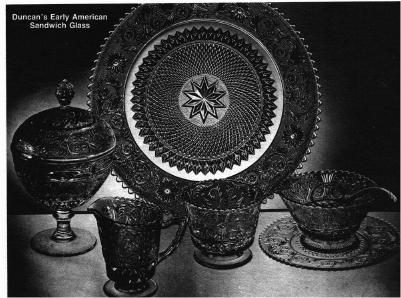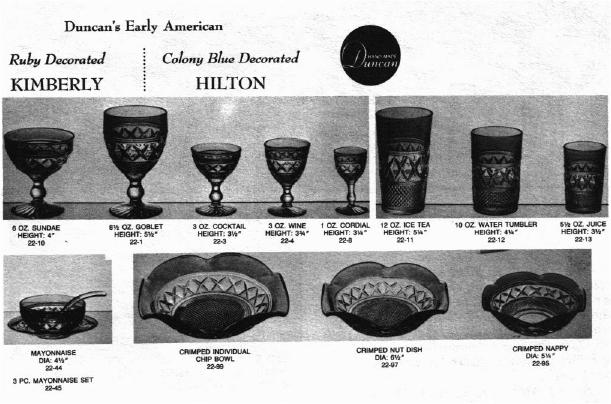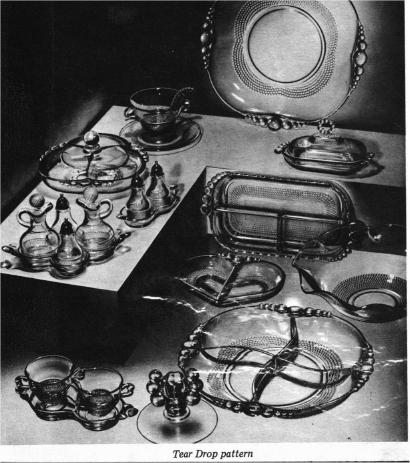National Depression Glass Association
Preserving America's Glass Manufacturing Heritage
Duncan Glass made at Tiffin, OH
by Fred Bickenheuser
Glass Review - July 1985
On July 20, 1891 the firm of George Duncan & Sons, manufacturers of fine Flint Glassware became Factory "D" of the U.S. Glass Company combine. The elder George Duncan had passed away some years before, but his name, which was well-known, was still being used in connection with the glassware company.
 In March,
1892, Factory "D" of the U.S. Glass Company was destroyed by fire. The
only building not destroyed by that fire was the mold building. All of
the Duncan molds had been spared. Later they were moved across the
street to Factory "I" of the U.S. Glass Company. This tooling was used
for years afterwards in the manufacture of early Duncan patterns.
In March,
1892, Factory "D" of the U.S. Glass Company was destroyed by fire. The
only building not destroyed by that fire was the mold building. All of
the Duncan molds had been spared. Later they were moved across the
street to Factory "I" of the U.S. Glass Company. This tooling was used
for years afterwards in the manufacture of early Duncan patterns.
James E. Duncan left the US Glass Company and with John K. Miller and others founded the Duncan & Miller Glass Company in Washington, PA.
History, and especially the history of families involved with the manufacturer of glass table wares, has a way of repeating itself.
In 1955 the Duncan & Miller Glass Company, Washington, PA became the Duncan & Miller Division of the U.S. Glass Company, Tiffin, OH. At this point in time the huge combine of the U.S. Glass Co. (thru sixty-four years of fires, floods and the Great Depression of the 1930's) had dwindled to just TWO glassware factories. One in Tiffin, OH and the other in Glassport PA.
 James E. Duncan III was president of the Duncan & Miller
Division of the U.S. Glass Company and in their catalog No. 93 (1955)
indicated that the "Flame polishing and the hand finishing was under
the direction of the third generation of the Duncan Family." James E,
Duncan III had worked with the unions and the management of the U.S.
Glass Co. for two years prior to forming the D&M Division of that
company. With him he brought the molds and tooling necessary to
continue the manufacturing of such patterns as: Sandwich pattern No.
41, Canterbury, Tear Drop, Duncan Swans, Pall Mall pattern No. 30, and
many more. Most important he brought with him the skilled glass workers
who possessed the knowledge to produce the colors and the special
clarity of the crystal that Duncan & Miller was noted for.
James E. Duncan III was president of the Duncan & Miller
Division of the U.S. Glass Company and in their catalog No. 93 (1955)
indicated that the "Flame polishing and the hand finishing was under
the direction of the third generation of the Duncan Family." James E,
Duncan III had worked with the unions and the management of the U.S.
Glass Co. for two years prior to forming the D&M Division of that
company. With him he brought the molds and tooling necessary to
continue the manufacturing of such patterns as: Sandwich pattern No.
41, Canterbury, Tear Drop, Duncan Swans, Pall Mall pattern No. 30, and
many more. Most important he brought with him the skilled glass workers
who possessed the knowledge to produce the colors and the special
clarity of the crystal that Duncan & Miller was noted for.
For many years after James E. Duncan III had passed on, the Duncan & Miller patterns were still being produced by the Tiffin Glass Co. (In May of 1980 when the multiple pot furnace at the Tiffin Glass Co. was turned off, the Duncan & Miller pattern "Canterbury" was being produced.)
So important was James K Duncan III contribution to the glassware industry that a complete chapter of the Duncan & Miller items made by the U.S. Glass Co. is included in Book II of the Tiffin Glassmasters Series.
 |
 |